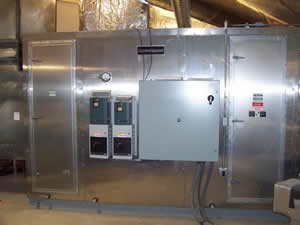Pool Dehumidification Design
A pool enclosure, by definition, contains a large reservoir of water that acts as a humidifier for the air in the space. For each pound of water that evaporates from the pool, approximately 1047 BTU is required to vaporize the water. This heat comes primarily from the pool water and from the air directly above the pool surface, effectively cooling both. In order to maintain pool temperature, space temperature, and humidity at the recommended levels, the air must be constantly dehumidified and heated, and the pool water must also be heated. A dehumidifier, which works by condensing moisture out of the pool space air, is an efficient and effective way to transfer the heat recovered from the condensation of water vapor (dehumidifying) back into the pool water and the air in the pool space. Due to the mechanical work of compression in the heat pump compressor, heat is delivered back to the pool air and water than is recovered in the dehumidification process. During times (summer) when this additional heat is not needed, an auxiliary outdoor condenser is required to remove the heat from the building, but still requiring the compressor to operate. An alternative strategy employs the TBS patent on E-Max Solar/Geothermal technology that only operates a compressor when heating or cooling is actually required. Using outdoor air for dehumidification is an energy conserving alternative that works very well in the northern United States.
Pool Dehumidification Design - Project Savings Performance Table
| Annual Savings | Fuel Oil Reduction (gallons No. 2) | Electrical KWH Reduction of (Increase) | CO2 Reduction Tons/Year | |
|---|---|---|---|---|
| Pool Area, AHU-1 | $22,417.57 | 11,546 | (7,852) | 125 |
| Locker Room, AHU-2 | $1,065.00 | 500 | 0 | 6 |
| Geothermal System | $12,250.00 | 11,426 | (73,444) | 86 |
| Totals: | $35,732.57 | 23,472 | (81,296) | 216 |
| Based on $2.13 per gallon, $0.14/kwh, geothermal @ $0.79 kw/ton estimated for 2007. | ||||
| The above table reflects the actual savings for a 3,200 square foot indoor pool when converted from mechanical dehumidification using a compressor to ventilation dehumidification using outdoor air with variable speed drives, passive heat recovery, andgeothermal energy as the source of heat for pool water and air heating. | ||||
| The net CO2 figures above include the decrease in CO2 generated on-site and the increase CO2 production at the electric utility plant for the total net reduction into the environment. | ||||

|
